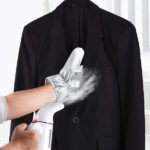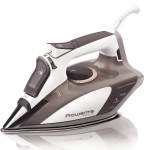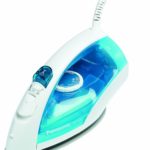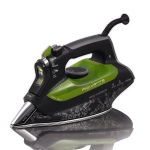This post contains affiliate links which will enable us to earn some commission if you click and buy.
We have a clothes iron buying guide to help you out if you are shopping for a unit for your home. There are tips on buying a steam iron in that guide while here, we intend to review features that are commonly found in this small appliance. Some features could be important to you while others you might be able to live without. It all depends on your situation and preferences and different people will have different needs. So, an iron that will work for one may not necessarily be the best choice for another.
Below are the steam iron features to look out for:
Watt
Generally, the higher the wattage, the quicker and hotter the iron gets. For example, the Hamilton Beach 14210R is a 1200-watt iron and you have to allow at least 2 minutes for the iron to reach the desired temperature. On the other hand, the T Fal FV4495 Ultraglide could heat up in half the time but it is a 1725-watt unit.
Naturally, a more powerful iron also tends to be more expensive but it should give a better ironing experience overall with the higher heat output.
Soleplate
Soleplates should not snag or stick to the fabric. The nonstick ones could be smooth and slick when new but there is always the risk of the coating peeling as the iron goes over zippers and buttons. Polished stainless steel ones are still best for crisp results and some could be coated with platinum (like the Rowenta DW9080 Steamium), and other elements for even stronger nonstick and scratch-resistant properties.
Apart from the material, the shape of the soleplate can also differ from one model to the next. Nowadays, with better research and technology, some irons have rounded soleplate bottoms and even double tips such as the Panasonic NI-W810CS Multi-Directional iron, for minimizing wrinkles as the appliance is pushed back and forth across the fabric.
Steam Vents
The number of steam vents on irons can vary widely. The cheap ones may have about 20 large holes while the higher end models could have hundreds of micro steam holes. However, whether the number of steam holes contribute to better results remains debatable.
The general feeling is that the higher the number of holes, the better the steam diffusion is. As the steam is more evenly spread out, more areas are covered at a faster rate. That is the selling point of the Rowenta DW5080 Focus with its 400 micro steam holes.
Steam Blast

This is a common feature on steam irons. The button for the steam blast is usually located right at the edge of the handle where your thumb is within easy reach. Also known as shot of steam or steam jet, you also use this button for vertical steaming and self-cleaning for certain models.
A press of the button would give you a shot of steam to erase stubborn wrinkles. It is a shame that not many iron manufacturers list the volume of steam output for their appliances that it makes the comparison between irons difficult. But generally, the more expensive the iron is, the higher the steam output should be. For example, the Rowenta DW9280 which is retailing for more than $100 at the time of writing, boasts of 30% more steam being forced into the fabrics with its pump injection technology.
Vertical Steaming
While most irons with a steam blast would also have the vertical steaming feature, it is not a given either. So, do check for the option if you have items that require vertical steaming to be done. The unit needs to be able to steam when held upright and a shot of steam that could be re-activated in short intervals.
Variable Steam
This is usually a lever that you can move from left to right and back to control the amount of steam output. Also known as adjustable steam, different materials will need different levels of steam for best results. Some models will only have steam output on higher settings, usually from wool to cotton/linen but not for the lower temperatures. Also, different models will give you different amounts of steam output but the more steam is generated, the more water it uses up which means more refills of the tank will be needed.
Temperature Control
The most common controls is in the form of a dial. The majority are located below the handle and you simply turn the dial to the fabric setting that you want. Below the handle is probably the only location that you can have a big dial that is easy to read although the drawback is you may unknowingly knock it with your fingers when you grasp the handle.
The other option is to have the dial located at the front of the iron like the Sunbeam Steam Master but there are not many models with this design. Another alternative is to go digital. Instead of a thermostat dial, you change the settings by pressing a button and your choice is then shown via a small LED display. One of the best steam irons, i.e. the Black & Decker D2030 is one such unit.
Self-cleaning
This functions to flush out deposits from the iron so that the vents are not clogged up over time. As mentioned, a lot of models will make use of the steam blast feature to unclog the vents. Other models will have a separate button for cleaning purposes.
The general rule is to clean the unit once a month to maintain its performance and prolong its useful life.
Anti-calcium
This is an addition to the self-cleaning feature. The anti-calcium can be a valve that acts as a filter that you need to clean periodically or it can be an integrated system in-built into the unit. It collects scale to prevent calcium built-up due to the hardness of the water.
That is why many irons nowadays allow you to use ordinary tap water rather than distilled. In fact, some irons do not recommend you to use purely distilled water. So, do read your instruction manual on the type of water you need to use with your iron if you want it to last.
Anti-drip
This feature is to prevent leaks when the iron is not hot enough to steam. If it works properly (some are not perfect), the unit should have no leaks when you are using it on the lower temperature settings or when it is still heating up to your desired level.
Spray Mist
This is a common feature as well. But if you are buying a classic/basic iron like the Black & Decker F67E, this feature may not be available. But overall, it can be found on most models although different irons would give you a different amount of water output. Some give a fine spray while others may result in blotches on your clothes.
Water Tank
How you fill the iron may also be important for some. Look for irons with a bigger hole, if possible, because that makes it easier to fill and you are less likely to have water running down the sides of the iron. Some irons also have a detachable water tank (e.g. Panasonic NI-C78SR) which makes it even easier to refill.
The other important consideration is the size of the reservoir. Some can fill about 6 ounces of water while others can go up to 12 ounces like the Rowenta DW8080 Pro Master. However, bear in mind that the larger the water tank, the heavier the iron would be when it is filled to the maximum. But on the upside, you will not need to refill as often.
If you have poor eyesight or if you often iron at night, you might also like a clearer water tank rather than a dark colored one which makes the water level difficult to see.
Auto Shut-Off
This is a safety feature that most irons would have. The better quality ones will offer a 3-way shut off – on its heel, side and soleplate. The other point to consider is the amount of time it takes before the iron powers down. Some models will shut off after 8 minutes of being left idle on its heel. For others, like the Sunbeam GCSBBV-395-000 Classic, it could take as long as 30 minutes. Having a longer interval before the unit shuts off might be an important consideration for those who do sewing and quilting.
Cord
The usual cord length for irons is about 8 feet. It can go as long as 12 feet with the T Fal FV4495. Some models also have retractable cords for easier storage like the Panasonic Ni-E650TR U Shape iron. Get an iron with a swivel cord, if possible, for more flexible cord movement to minimize stress on the wire as well as to keep it out of the way while ironing.
The other consideration is to go cordless. Instead, you have a charging base with no cord attached to the iron to tangle with. A popular model for this is the Panasonic NI-L70SR.
Weight
The overall weight of the iron is also an important consideration. A lightweight iron is easy to move around without hurting the hand. But the downside is you will have to apply more pressure when there are tougher wrinkles to get rid of. Generally, the higher end irons are on the heavier side. They feel more solid and the weight helps to erase the wrinkles with less passes. But they can be tiring on the hands, especially when you need to hold it upright for vertical steaming.
For most people, irons around 3 lbs feel just about right. Anything less than 2 lbs will be a little too light that it feels kind of flimsy while those weighing over 3.5 lbs can be quite heavy once filled with water.
Conclusion
In our opinion, the best steam iron features would include a higher powered unit of at least 1500-watt, high steam blast and continuous steam, anti-calcium filter and fairly large water tank (maybe around 8 ounces capacity). Other features such as weight, type of soleplate and cord length are more about personal preferences.
Of course, the better the features, the more expensive is the steam iron. But you get what you pay for and higher end models will usually give you a copious amount of steam with a slick soleplate that heats up quickly and evenly to easily smooth out wrinkles. With a good quality iron in your hands, you will get the feeling that ironing has become less of a chore.




I’m curious about whether or not there is a clothing iron what has an auto power stream button. By that I mean when you press the steam button an electric motor pumps out the steam, rather than the pressure being dependent on how hard you press the button. I’d like to have something like that because my arthritis acts up when I iron clothes. Think of it this way: Thanks to power steering in cars, drivers don’t need brute strength to execute a turn. Can’t we apply the same concept to steam irons?
Nobody is commenting on this post, but my arthritis acts up also. Don’t iron like I used to, but when I do I would like a smaller compact iron like they used to make years ago. Irons are made too large for my hands & find them to be too big & bulky. What brands are the smallest in size or are they not made like that anymore?